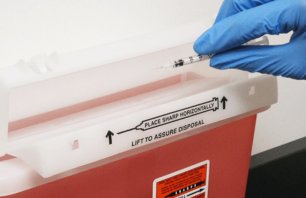The Hazards of Bloodborne Pathogens
One of health care’s most critical worker safety risks is the exposure of bloodborne pathogens (BBPs). The three most recognized BBPs are human immunodeficiency virus (HIV) and the Hepatitis B (HBV) and hepatitis C (HCV) viruses, but there are other bloodborne viruses and bacteria that present threats of infection and disease to health care workers. The greatest risk of infection comes from percutaneous injuries by contaminated sharps from a needlestick or potentially during use of scalpels and sutures. Exposure may also occur when a worker comes into unprotected contact with other potentially infectious materials (OPIM): various body fluids and unfixed tissues or organs “visibly contaminated with blood, and all body fluids in situations where it is difficult or impossible to differentiate between body fluids.” If staff comes into contact with OPIM of an infected patient and it makes contact with a worker’s mucous membranes of the nose, mouth or eyes, the threat of infection rises.
Compliance with OSHA Increases Worker Safety
To help protect workers against the health hazards of bloodborne pathogens, the Occupational Safety and Health Administration(OSHA) promulgated the Bloodborne Pathogens Standard that requires employers to protect workers who can “reasonably be anticipated to come into contact with blood or OPIM.” Health care organizations must comply with safeguards that reduce the chances of BBP exposure and must provide post-exposure follow up evaluation and prophylaxis.
Several Key Elements of Risk-Reduction Prescribed by OSHA
1. Hand Hygiene
Clean hands go a long way in preventing the spread of any contaminant, including BBPs. OSHA requires that health care organizations ensure workers “wash hands and any other skin with soap and water or flush mucous membranes with water as soon as feasible after contact with blood or OPIM.” In general, health care workers should know how to thoroughly and completely wash their hands, as well as where the closest cleaning stations are located. OSHA requires that handwashing facilities are readily accessible by points of patient care.
2. Sharps Containers Placed Appropriately
While OSHA does not specifically define the type of container an organization must use, specially-designed, puncture-resistant containers made to safely store used needles, scalpels, broken glass and other sharp items help to minimize or reduce potential exposures. Organizations should place sharps containers in the immediate area of patient care, so that workers can safely and efficiently dispose of sharps after use.
3. Proper Disposal of Personal Protective Equipment
Personal protective equipment (PPE) plays an integral role in avoiding BBP exposure and is required by OSHA’s BBP Standard to be readily available and in appropriate sizes for all affected health care workers. The PPE must be removed and disposed of in a designated area or container for storage, washing, decontamination or disposal.
4. Comprehensive Bloodborne Pathogens Training
Any employee who is potentially at risk for exposure must receive detailed orientation and at least annual refresher training that reviews the requirements of the BBP Standard. When new or modified tasks or procedures affect a worker’s occupational exposure, employees should have additional trainings to reflect the new or heightened occupational risks. Online training modules, such as those offered by Stericycle, can be especially helpful with this training as staff can access the content at their convenience and gain a full picture of their role in preserving safety. The modules are updated as required, so organizations can be confident that they are consistently in compliance with OSHA requirements.
Bloodborne Pathogens Are a Concern for More Than Just Hospitals
Citations regarding the BBP Standard topped the list, as they often do, of citations in the hospital industry in 2018 but all health care facilities must stay vigilant in complying to OSHA’s safety standards. For example, dental staff have ongoing potential for exposure to saliva and blood, in combination with the presence of sharps, such as needles and wires. Like other health care organizations, dental facilities must establish a written Exposure Control Plan, detailing requirements like the offering of Hepatitis B vaccinations as well as post-exposure prophylaxis.
Beyond the health care environment, the BBP Standard also applies to any workplace with potential occupational exposure to human blood or other potentially infectious materials.
Stericycle can be a valuable resource in helping your organization minimize risks and develop the necessary elements to achieve and sustain compliance with OSHA’s BBP requirements. Learn how our OSHA Compliance and Training programs can help keep your staff safe and your organization in compliance today and in the future.



